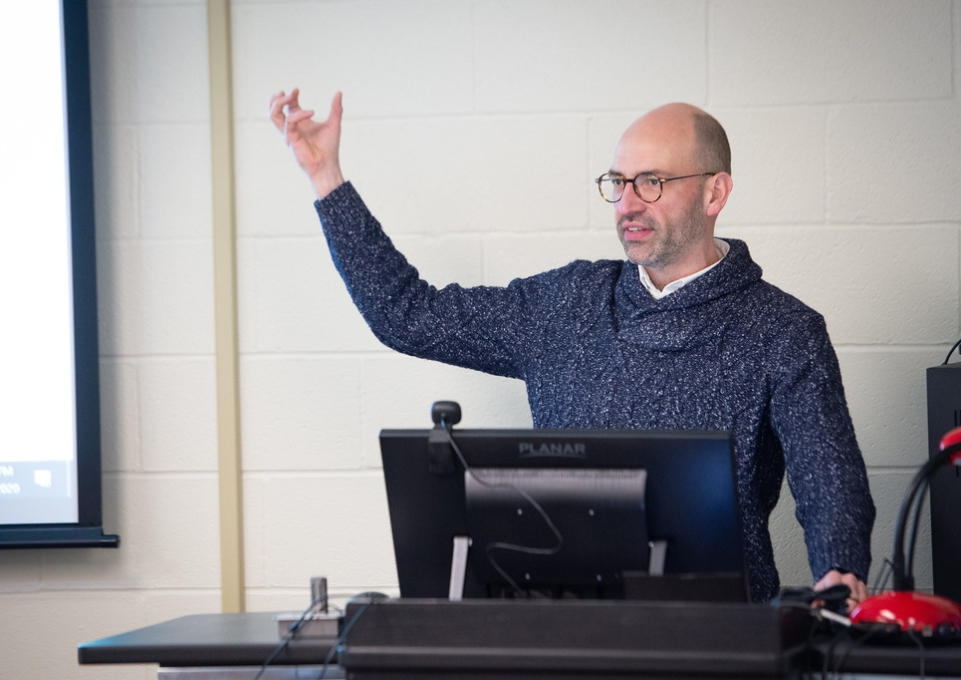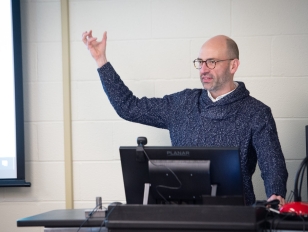
John Draeger, professor of philosophy and director of the Teaching and Learning Center (TLC), and the team he works with, Instructional Design and Training (IDT), have been quite busy since March, when the coronavirus pandemic first gripped the United States. How busy? Since then, they’ve run over 350 training sessions and webinars, reaching almost 550 distinct faculty members.
“It’s incredible to me,” Draeger said. “And that’s just a fraction of what IDT does. Most of what they do is on the back end, and no one even knows about it.”
The switch to remote learning in the spring fell largely on the TLC and IDT, who needed to make sure faculty members were up to speed with the various programs for online learning. All faculty members—from those who had never once so much as signed in to Blackboard to those who just wanted to get more out of the technology—fell under the purview of Draeger and IDT team members Meghan Pereira, Brooke Winckelmann, and Todd Benzin.
“The range was from someone who doesn’t really know how to turn on a computer to people who are already power users but wanted to figure out how to take it to the next level—and everywhere in between,” Draeger said.
The team has conducted trainings on various aspects of Blackboard Learn, how to use Blackboard Collaborate, how to develop online courses, ways to support students through remote learning, and debriefings on what worked and what didn’t during and after the transition to remote learning, as well as a number of others. Workshops and webinars continue to be offered.
Along with the trainings, IDT was also responsible for making sure content was delivered to students properly. For Benzin, that meant ensuring the videos faculty members uploaded were captioned correctly, and for Winckelmann and Pereira, it meant making sure faculty members were able to access the new features in Blackboard they were learning how to use. It’s a lot of work behind the scenes, Draeger said, that often goes unnoticed.
“I can't even count how many back-end tasks and all the different things they’re doing and different requests they’re getting,” he said. “They get so many people e-mailing who don't understand the ticket system, so they’re answering tickets and answering e-mails.”
The faculty has responded to the challenge as well, Draeger said. Some have taken multiple trainings since March, averaging six or seven apiece, and a few have taken more than 40 of the available trainings and webinars.
“You can’t just take what you do in class and throw it online,” he said. “It doesn’t work that way. But I didn’t hear any grumping or grumbling. Faculty really wanted to do the right thing for our students.”
The team has learned a lot of lessons since the spring, Draeger said, and works actively to provide the best possible services to faculty. They don’t always “know what they don’t know,” but they strive to be as helpful as possible.
“Our goal is to put together the best programs we can,” he said.
To that end, the staff are dedicated to their own professional development, as well, Draeger said.
“They’re also going to sessions, like SUNY sessions and industry sessions, because they want to try to have more tools to bring to campus,” he said.
Draeger said he’s proud of the team, and all the work they’ve done to ensure that Buffalo State’s students are still getting the best educational experience possible.
“I just can’t say enough about these folks,” he said, referring to Pereira, Winckelmann, and Benzin. “Most of what they do is behind the scenes, and I only know about it because I have a front-row seat. If you want to get something done, they’re the three you need to reach out to, because they’re going to figure it out, whatever it takes.”
Pictured top: Todd Benzin, educational technology specialist, runs a remote instruction training session for faculty members at the onset of the coronavirus pandemic in March. Scores of trainings and related troubleshooting have kept IDT hopping since the first wave of the pandemic shut down SUNY campuses in spring 2020.
Photos by Bruce Fox, campus photographer.



